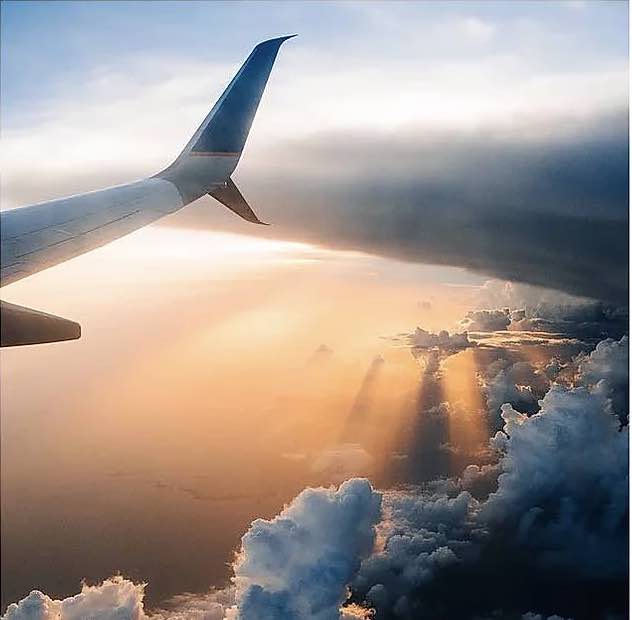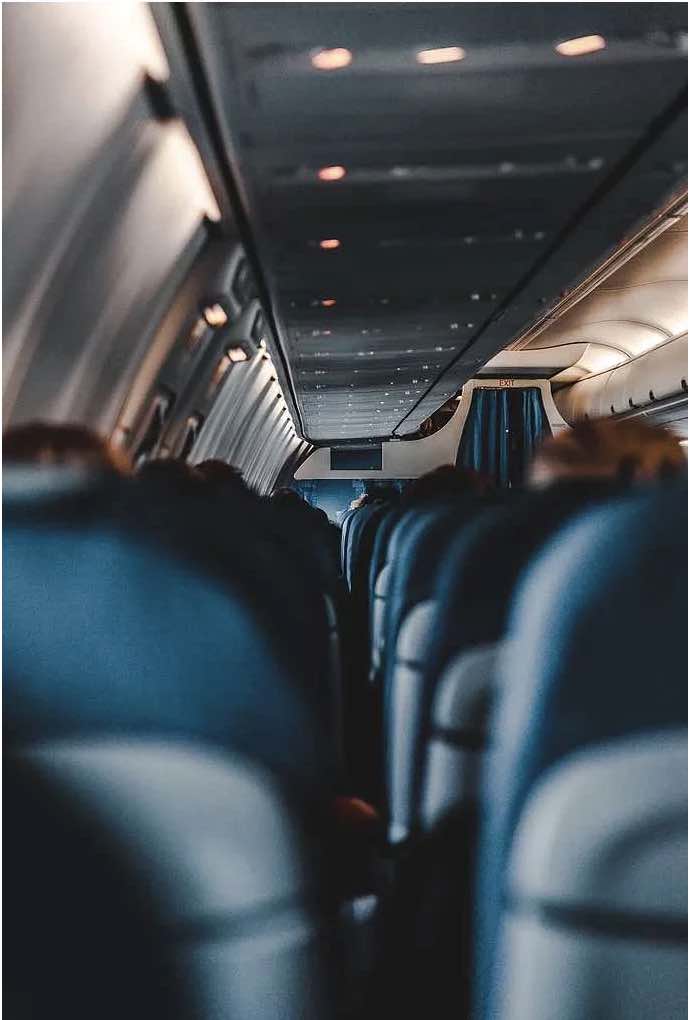by Daniel | Last Updated January 5th, 2022

Whether you’re a plane virgin or a seasoned travel veteran, there are always tips to improve how your flight goes. From airline and TSA regulations to packing wisely, there’s a lot to think about before every trip. You’ll want the experience to be as smooth and stress-free as possible.
I’ve scoured the internet and racked my travel brain for the best flying tips. If you want to learn how to make your next flight your best one yet, keep reading for my best-kept airplane travel tips.
Struggling to pack? Check out my hacks for packing here.
Book Far In Advance
As far in advance as to when you book your flight, there are already a few things you should do to plan ahead and make your travel day as easy as can be.
Paperwork Prep

First, keep records of all of your booking confirmation information. Save all emails in a separate e-folder on your account. When it comes time to check-in, you’ll be able to pull up your confirmation number immediately. Make printed copies, if you can. In a worst-case scenario, there may be issues with your ticketing. Having this paperwork on hand will make your info much more accessible.
Other paperwork to prepare ahead of time includes:
- Passport or valid state ID
- Copies of your tickets if possible
- Any travel insurance documents
- Luggage tags with all of your pertinent information on them
It’s a good idea to consolidate all of these documents into one folder so that you have everything in easy reach once you’re at the airport.
Luggage Check

Another tip to take care of as soon as you book your flight is assessing your luggage needs. Make sure you have bags that will fit those requirements.
Many airlines charge extra for carry-on and checked bags now, so it’s important to take a look at their pricing policy to anticipate how much extra it will be to bring on your luggage. Many airlines will offer discounted rates on luggage when purchased in advance online, so this is also a good time to go ahead and purchase those to save some money.
Once you’ve paid for your bags, make sure you have bags that will meet their size requirements for whatever kind of luggage you paid for (checked or carry-on). You should also keep in mind that you’re usually allowed to bring only one personal item to keep beneath the chair in front of you, so double-check those measurements as well.
If you don’t have the right bags at home, you may need to go out and find new ones. Most luggage options will display dimensions on the packaging.
The Week Of
The week of your travels, this is where the planning gets real.
Pack Like You Mean It
Since you already have the correct sized luggage, now it’s time to strategically plan what to pack and begin organizing the suitcase.
Avoid worrying that you’ll forget something by using comprehensive packing lists online. These should include items you tend to leave behind accidentally. Even glancing over a few of these after packing may remind you of some extras you’d like to bring along.
Keep in mind the current weather at the place you’ll be traveling to. Even if it’s hot where you are, to begin with, the place you’ll arrive at may have a drastically different climate.
A tip for packing your everyday items is to scan your body from head to toe, asking yourself what you need for each part:
Starting at the head, you may want to bring:
- Sunglasses
- A beanie
- Hair products
- A straightener
- Face wash
- Makeup
- Earrings
- Contact solution
- Earphones
For your upper body you’ll want to bring:
- Undergarments
- Short and long-sleeved shirt options
- Outerwear
- Gloves
Continue this process all the way down your body and you’ll be surprised at how many items you just crossed off your packing list!
Once you’ve set aside everything you need to pack, it’s time to start organizing the luggage. Vacuum sealed bags and packing cubes are great options to separate and organize different items in your suitcase, so consider that if you need to stuff a lot in there. Rolling clothes is also a great way to save space and make it easy to see everything in your bag once you open it.
Consider TSA

When you’re packing and preparing for your flight, it’s crucial to keep in mind all of the TSA regulations and restrictions on what you can and cannot bring on a plane.
TSA does not allow you to bring on any liquids in a carry-on or personal item larger than 3 fluid ounces, and your bag will get flagged if you bring them. All of your liquids should fit into a quart-sized clear plastic bag and should be easily accessible so you can take it out during the TSA screening process.
They also do not allow the transport of any weapons, hazardous materials, flammables, or firearms via carry-on or personal item. Some of these items may be allowed with special instructions in checked baggage, but you should check with your airline or contact the TSA to double-check.
Lastly, large electronic items will be noticed by the TSA. These are allowed, but they must be removed from baggage during the screening process. Consider this and keep your laptop or iPad in an easy-to-reach spot.
Extras You May Want
While you may have all of your essentials packed for once you arrive at your destination, you may not have thought about the hours you’ll spend in an airport or on a plane, and there are some extras you may want to bring to make that more enjoyable.
Water
For starters, consider bringing a reusable water bottle. As noted above, TSA does not allow you to bring liquids over 3 ounces, so any water bottles you have will need to be dumped out. If you bring an empty reusable bottle you can bring it through without an issue and fill it up at a water fountain in the terminal, saving you from paying for expensive airport water.
Entertainment
You also may want to bring some reading material or other forms of entertainment for the flight. E-readers are great for this since you can store so many different books in one small item, but some people still prefer paper books.
You can also download movies or shows to your laptop or tablet in order to enjoy them while in flight. Even downloading a new playlist you’re excited about can keep you entertained while you look out the plane window.
Consider that some airlines may offer WiFi in the air for a small fee or for free, so you may want to check on that to see if you need to download your entertainment beforehand after all.
Comfort
Other extras that can make your flying experience more comfortable include
- A neck pillow
- Small blanket
- Big sweater
- Circulation socks
- Hand cream
- Hand sanitizer
- Noise-canceling headphones
- A few snacks
The Day Of
When the day has come and it’s time to fly, here’s what you should do for a peaceful flight.
Getting to the Gate
Since you have everything packed and ready to go, you should be able to just grab your suitcase and your folder of documents and head to the airport!
When you arrive, it’s time to check in. Many airlines now allow you to check in on your phone to save time, but if you have to check a bag you’ll need to find the check-in desks regardless. The attendant will be able to update you with any information about time changes and gate numbers to send you to the right place with enough time to make the flight.
Then, you’ll pass through TSA security screening. Here, you’ll take out your liquids and electronics as well as remove your outerwear and shoes in order to get a thorough safety scan. Once you make it through, you’ll head to your gate and wait for the time to board.
Once boarding begins and you make your way onto the plane, find your seat and get your luggage situated. Make sure you have everything you might need during the flight under your seat so you don’t have to go back into the aisle and reach into the overhead bins during flight.
Get comfortable in your seat and double-check the literature that’s usually in the seatback pocket to refresh yourself on (or learn) the safety guidelines and procedures. The flight crew will review this as well as inform you of your flight time, arrival time, and the weather of your destination. Once this is over, the flight will begin.
In-Flight

If you brought snacks, you’re all set. If not, many airlines will offer food and drink for a fee. The cabin crew will come down the aisles to take your order once the cruising altitude is reached. Don’t be the person that eats tuna or boiled eggs on a plane, though. No one likes that person. Just be considerate of those around you with whatever you eat or drink.
